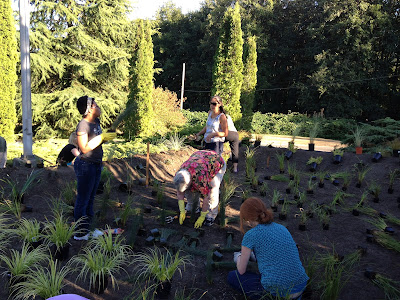Brian Stahl from Kitsap Conservation District is hoping for rain. I stopped by the office this sunny September morning and got a tour of the Conservation District's on-site rainwater collection system. The cistern is empty at the moment and even though there isn't a cloud in the sky, Brian, is thinking about the winter rain water that will run off the building roof and fill up the 11,000 gallon tank. The water stored in the tank will flush the district building's toilets and, next summer, provide outdoor irrigation water.
 |
| 11,000 gallon cistern |
I immediately asked where he got such a huge tank. He told me that this rainwater collection system project started with a phone call from a small farm owner. He asked Brian if he could find a home for this good as new cistern that he couldn't use. The Conservation District offers assistance to landowners to protect natural resources, so Brian started asking around. When he got no takers, he decided to design a rainwater collection project at the office. The costs incurred fit nicely with a grant he received for rainwater collection.
 |
| filter and booster pump |
This is how the project will work. The roof downspouts are all piped to a 1,500 gallon tank buried in the ground near the building. As soon as the 1,500 tank has reached its holding capacity, the rain water is pumped to the 11,000 gallon cistern.
 |
| Brian next to his electronics |
A submersible pump will send the water from the 1,500 tank to a filter.
The water will then be pumped directly to the district's irrigation
system and to the building for flushing toilets. Brian is waiting for permits to connect the pipe into the building for the toilets.
 |
| Future connection to the inside toilets |
When the 1,500 gallon tank starts to drain; water from the large cistern will be gravity fed into this smaller tank to replenish the water. If the cistern becomes depleted, the toilet flushing will seamlessly revert back to well water.
If however, the huge cistern fills and overflows, the excess water will be channeled into the rain garden where the rain will make its way to the aquifer. The rain garden has its own overflow system that has never been used. Brian thinks this may be the year.
 |
| The rain garden closes the loop |
Brian can hardly wait to watch the see-through tank gauge on the cistern fill with water. I think Brian would be glad to share his rainwater collection project with you. Contact him at the
Kitsap Conservation District.














